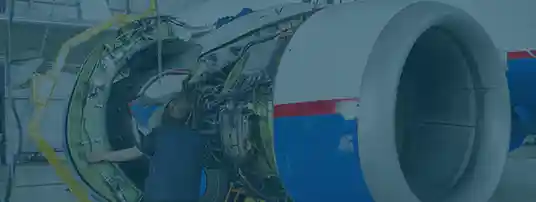Posted on March 23, 2022 linda strong aerospace
One of the leading reasons aircraft incidents occur in cold weather is due to aircraft icing. Aircraft icing is defined as the coating or deposition of ice on any part of the aircraft, caused by the freezing of liquid hydrometers. Such occurrences make it hard for pilots to efficiently and safely navigate aircraft.
Other factors that may increase an aircraft icing threat include environmental temperatures, aircraft speed, aircraft surface temperature, the shape of the aircraft surface, particle concentration, and particle size. In terms of particle size, small droplets follow the airflow and form easily around the aircraft wing while heavy droplets strike the wing with more force. As there are many parameters to consider, this blog will provide a brief overview of aircraft icing, its types, and where it forms.
When small droplets hit the aircraft, they typically spread back over a small distance of the wing. Meanwhile, large drops have the ability to spread further. Keep in mind that as the airspeed increases, the number of droplets that strike the aircraft also increases. Similarly, the rate of aircraft icing catch is also influenced by the curved structure of the wing’s leading edge.
Thick wings tend to catch fewer droplets than thin wings. For this reason, aircraft with thin wings that fly at high speeds through large droplets possess the greatest rate of aircraft icing catch. There are a multitude of ways in which ice can collect on the surface of an aircraft and obstruct the function of wings, propellers, and control surfaces. That being said, the next section will cover how icing affects aircraft.
Small leading edges like antennas, horizontal stabilizers, propeller blades, landing gear struts, and rudders are some of the main regions to accumulate ice. Typically, ice first forms on the thin, outside air temperature gauge, taking over the wings at the end. Moreover, a thin coat of ice may also form on the aircraft windshield, usually occurring upon landing and take-off.
Accumulated ice has an immeasurable effect on lift and transforms the cross-section of the airfoil. More than that, it increases drag and stalling speed as well as degrades thrust. Such an occurrence forces the pilot to use a high angle of attack and full power to maintain a safe altitude. However, with a high angle of attack, ice will form on the wing’s underbelly, adding more drag and weight. The next section will cover the four main types of aircraft icing, those of which include rime ice, clear ice, mixed ice, and frost.
Rime Ice
To begin, rime ice is distinguished by its milky white color and is found on the surface of the aircraft when it is flying through filmy clouds. This type of ice forms because of small supercooled droplets when the rate of catch is low. Usually found on the leading edges of wings, pilot heads, antennas, and more, rime ice forms when the temperature of the aircraft skin is below 0 degrees Celsius. Due to the low temperature, droplets freeze rapidly. Though rime ice is not heavy, it still alters the aerodynamics of wing camber and affects instruments. With deicing fluid and equipment, rime ice can be dislodged with ease.
Clear Ice
Clear ice, on the other hand, is heavier than rime ice and surfaces when aircraft fly through clouds that contain large amounts of big supercooled droplets. Often called glaze ice, clear ice spread unevenly over tail surfaces, antennas, propeller blades, and wings. It usually forms when a small part of a droplet freezes upon contact with an aircraft surface. Furthermore, airflow is severely disrupted by clear ice as it increases drag by 300% to 500%. When large chunks of clear ice break off, the resulting vibrations can impair the aircraft’s structure.
Mixed Ice
Next, mixed ice carries the properties of both rime and clear ice, and it forms when small and large supercooled droplets are present. It appears irregular, rough, and whitish, looking like frozen, liquid particles such as those found in wet snowflakes. Additionally, it accumulates rapidly and is hard to remove.
Frost
The last type of ice that can be found on aircraft is frost. Semi-crystalline frost forms in clear air through a deposition. Though it does not have a major effect on flying, it does obscure the pilot’s vision by coating the windshield. More importantly, it may interfere with radio signals by forming in the antenna. In fact, aircraft that are parked outside on cold nights have frost in the morning, forming when the aircraft’s upper surface cools below the temperature of the surrounding air. Similar to other types of ice, it must also be removed prior to take-off.
Conclusion
Aviation Sourcing Solutions is a trusted distributor of high quality aircraft hardware parts that have been sourced from reputable manufacturers that we trust. With over 2 billion items in our inventory, customers can source everything they need with ease. Initiate the procurement process with a competitive quote and see how Aviation Sourcing Solutions can serve as your strategic sourcing partner!

 The only independent
The only independent



“We Proudly Support Intrepid Fallen Heroes Fund that serves United States Military Personal experiencing the Invisible Wounds of War : Traumatic Brain Injury (TBI) and Post Traumatic Stress (PTS). Please visit website (www.fallenheroesfund.org) and help in their valiant effort”.
We Hope that You Will Visit Us Again the Next Time You Need Aircraft Parts and Make Us Your Strategic Purchasing Partner.
Request for Quote